Architecture Design
The movement of the wind is very difficult to predict and modern architects take this factor into account when they develop structure of the building as well as ventilation system. They base their decisions on the simulation data received from consultants. At a rule, wind is regarded as two interacting forces: 1) external wind that affecting a building from outside and internal one that circulates within the construction. Due to the time and cost limitations, it is hard to integrate and correlate the external and internal with one another.
In this chapter, I would like to show how leading architects deal with this problem. The discussion will be based on eight architects’ 8 projects that illustrate how the movements of the wind can be predicted. Apart from that, I would like to speak about one of the most recent construction projects, carried out in Tokyo. It is believed to accelerate the heat island phenomenon. Additionally, I would like to illustrate the decisions-making of various architects as well designers. The list of projects is presented in the following table.
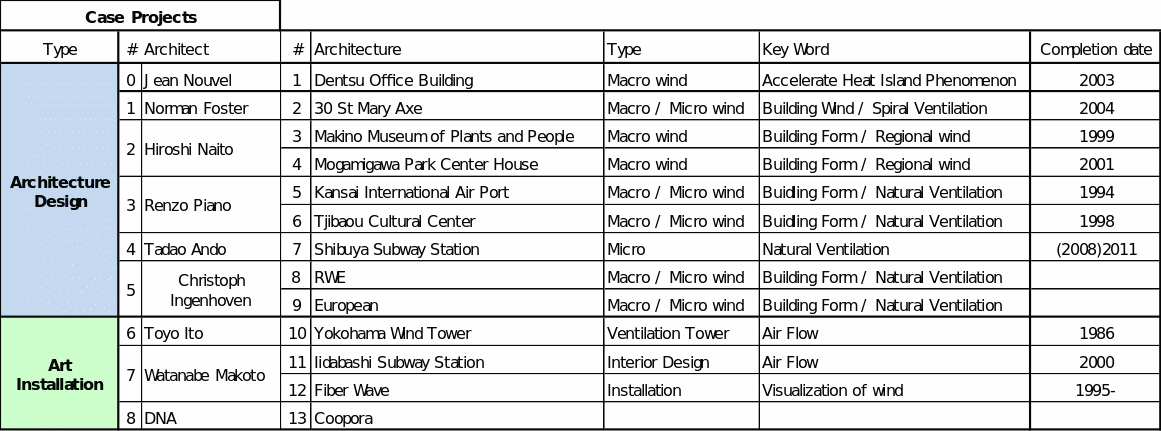
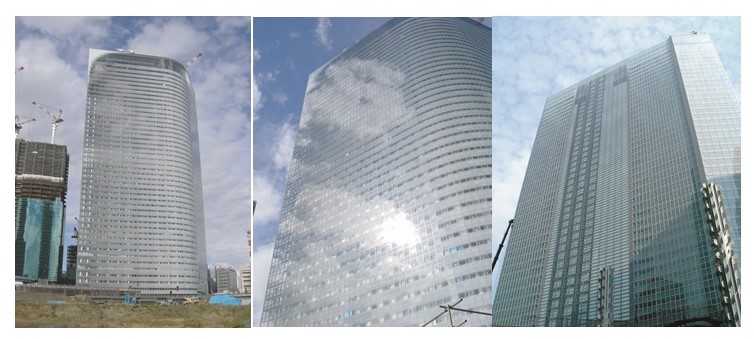
This picture shows the building which is said to have enhanced the heat island phenomenon in Tokyo, Japan. The building was designed by Jean Nouvel and constructed by Obayashi Corporation, Japanese general contractor.
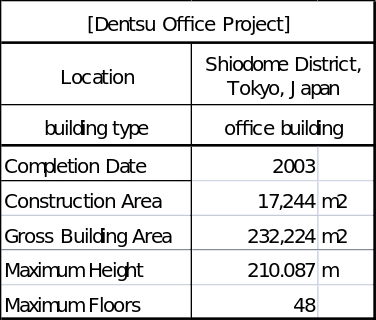
This construction was one of the 11 buildings of the Shiodome New Development Project in Tokyo. The district contains many companies’ new head offices, including the biggest TV company, Nippon TV, cosmetic company, Shiseido and other residential constructions.
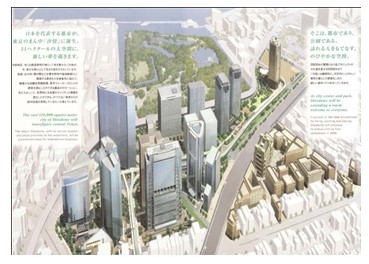
The district also incorporates a new train station, Shiodome. Total construction area is 300,000m2. Overall, it was one of the largest urban re-development projects in Tokyo, performed over the last decade. This district is located at bay side of Tokyo Bay. In close proximity, there is a spacious public park, called Hamarikyu, which lies between this district and the Tokyo Bay. In the back side of the district, there is the Shinbashi Station, one of Tokyo’s largest business areas. Also near the Shiodome, there are Tsukiji fish market, and Ginza, which is renowned as the center of commerce.
Dentsu was the first building completed in the district and one of the tallest buildings as well. So, this construction is regarded as the landmark of the area. The design of the Dentsu building was quite challenging at the time. The design of high rise buildings is usually limited by many structural and safety restrictions. Therefore the building usually resembled a box that looked rather heavy and coercively. Dentsu building does not fall into this category. Its architect Jean Nouvel tried to create irregular shape with white print glass. The shape of the building looks like a boomerang. Image and the shape of the building vary depending on the point of view.

Its design was thoroughly discussed by Jean Nouvel office and Obayashi design department during numerous internet meetings. They sketched many drawings to find the best proportion that could provide the sufficient office floor. Right bottom sketches are the actual drawings drawn at the first phase of the design. The left bottom models represent the final plan of the building. It is possible to argue that that the outlines of the constructions vary according to the angle from which the onlooker looks at (Please refer to the pictures, presented below). These graphical images illustrate this point.
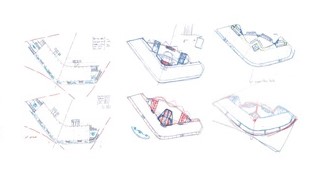
Nonetheless, the designers never underestimate the safety considerations and especially the probability of an earthquake. Therefore, each floor has 8 oil-dumpers and every 12th floor has 2 mega-bracings and mega-dampers to alleviate the force. Apart from that, in order to minimize the effects of an earthquake, the designers located a 2 hybrid-seismic at the top of the building.

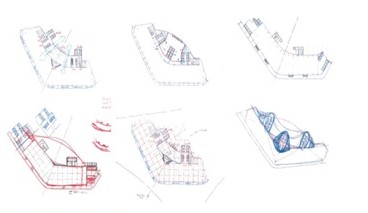
However, this building is nicknamed as “Tokyo Wall” as if it were big wall which prevents the ocean wind from coming into the center of Tokyo. After the completion of Dentsu building, temperature of Shinbashi Station area, back side of the Shiodome District, was reported to increased temperature. After the completion of the Shiodome area, people are started to associate with the temperature increase in Tokyo and Shiodome Area. In 2003, a report was submitted to Architecture Institute. It compared the wind environment around Shinbashi area before and after the completion of Shiodome Project by using both CFD and wind tunnel. The CFD simulation indicated that the Shidome Project is a enormous obstacle, hindering the wind flow that formely used to come in from the ocean side.
In addition, the wind tunnel simulation that compared the wind speed before and after the Shiodome Project showed that it considerable declined between Shiodome district and Shinbashi Station.

Unfortunately, at the time when I participated in the Dentsu project, both Jean Nouvel Office and Obayashi focused mostly on the immediate environment of the building. We did take into account its possible impacts on the urban part of the city. In 2000, numerous projects were turned in to the annual conference, held at Japanese architecture institute but none of them examined the impacts of this construction on the wind environment Tokyo. I have not found any study that investigated the dynamic of wind flow, especially in connection with the city of Tokyo.

On the other hand, after completion of the building, many researchers were carried out to identify the cause of heat island phenomenon. Undoubtedly, heat island phenomenon is caused by many factors and the Dentsu cannot be viewed as the sole culprit. But obviously, it contributed to the temperature rise and stopped fresh air comes into the Shinbashi station from Tokyo Bay. As a result, in summer people living in Shiodome area suffer from stagnating humid hot air.
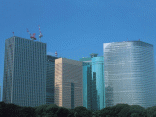
Furthermore, there was another determinant that contributed to the overall outcome. It should be mentioned that a great number of companies moved to this area. Thus the government started the study from 2005 to see the heat island phenomenon in Tokyo District not only the Shiodome area. In 2006, first heat island phenomenon institute conference was held in Tokyo and discussed about Tokyo’s increasing temperature and its measure. Now, the authorities decided to replace asphalt with special asphalt that can absorb water to cooler the ground floor to decrease the temperature.
But none of the building planning has reconsidered because it is impossible to change the location of building after constructed. At that time, I realized that that designers should pay close attention to wind dynamic during the planning stage.
This above picture demonstrates that the façade of the Dentsu building faces the ocean and one can have a truly good view from a window, but at the same time, this construction blocks the movement of the wind into the city and partly intensifies the island heat effect. This is one of the reasons why the subsequent high-rise buildings in Tokyo were constructed in such way that they did not instruct wind flow into the city. There are several project which prove that this goal can be successfully achieved.

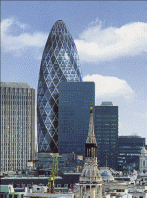
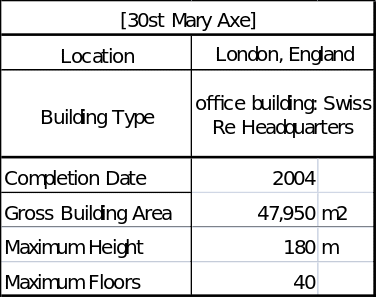
A year after the completion of the Dentsu building in Tokyo, Norman Foster designed high-rise building in London.
Yet, in contrast to the former one, the probable environmental burden of the building was closely examined.
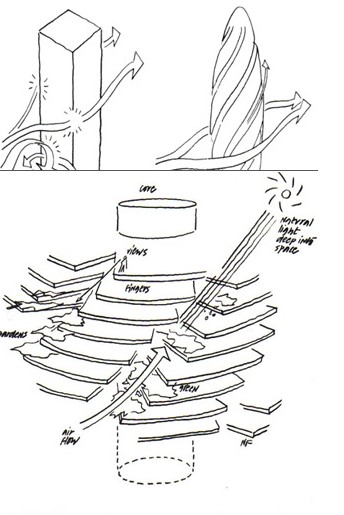
As the picture shows, its shape aims to minimize the turbulence. It can be characterized as streamlined and this helps to avoid the temperature rise.

The thing is that box-shaped high-rise buildings act like barriers that block the wind. Therefore, curvature shape was accepted for the building shape. The darken colored glass part creates the spiral void that allows the wind to circulate inside the window and in this way it reduces the consumption of energy, previously used for cooling and heating. Arup London took part in this project and acted as an engineering consultant who modeled the wind flow using CFD. According to the documented book about 30 ST Mary Axe1, the wind tunnel test confirmed the benefits of the circular form and enabled the project team to better design the ventilation system.
The building’s gigantic shape was later nicknamed “Gherkin”. It received the Stirling Prize in 2004 for applying energy saving technologies. Furthermore, this building was selected as the best new architecture in 2006 BD World Architecture 200. However, in June 2006, but according to the BBS survey it was viewed as one of the most unattractive buildings in London.
Many people seemed hard to accept this radical design at first. But afterwards many publications reported the advantages of the building in environmental point of view, the building was accepted positively. The building received many prizes due to the consideration of the energy savings. However, I personally feel this buildings’ reputation comes a lot from the sustainable technology not because of design. It is due more technological aspect of solution was accepted. From aesthetic point of view, the value of design can be questioned.
Naito Hiroshi
Naito Hiroshi is a Japanese architect, born in 1950, currently teaching at Tokyo University Graduate School of Engineering, landscape and civil design lab. He is well known architect in Japan for his attempts to integrate architecture design and engineering design. He is said to be the first architect who became civil engineering professor in Japan. He got the prize of architectural institute of Japan for Design in 1993 by designing sea-folk museum which used only natural ventilation. Naito said that though he applied natural ventilation for sea-folk museum, still gravity was the main factor for him to design the sea-folk museum. After completion of sea-folk museum, he began to focus on the wind flow. In many of his recent project, he relied on wind tunnel and CFD tests in order to simulate for the flow of air. At this point, I would like to discuss two projects that were created according to the principles of wind dynamics. One of them is Makino museum, whose roof was designed to better fit the movement of the wind. Additionally, I would like to talk about Mogamigawa Park Center House that was designed to avoid the so-called foehn phenomenon.
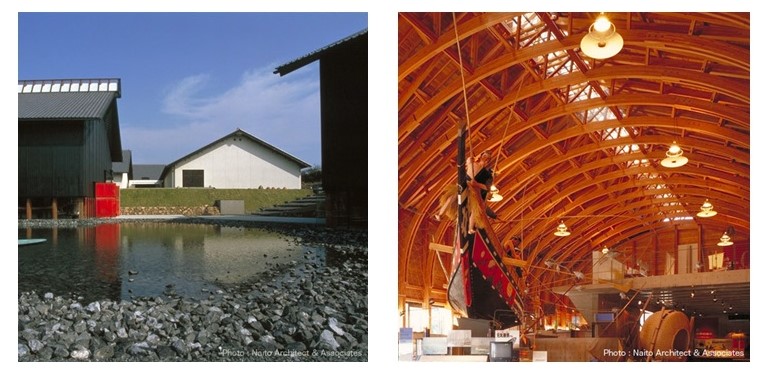
Makino Museum for plants and people
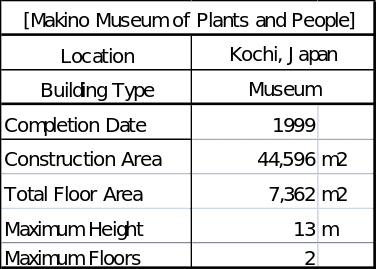
Makino Museum is located Kochi Prefecture in Japan. Kochi Prefecture is located Southern Part of Japan called Shikoku area facing the Atlantic Ocean. This arear is notorious for typhoons. The site of the museum is on the slope of the mountain.
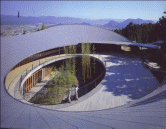
Naito decided to design the museum not to conflict with the landscape and merge into the surrounding scenery. Since the site receives strong wind, the museum should reduce the resistance of the wind. According to Naito, his primary concern was the impact of the external environment on the building.
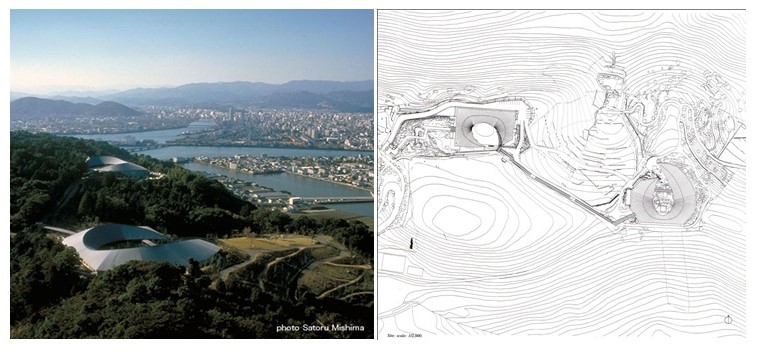
The key word he came up for this design was to “lie down” like fallen leaves or flatfish. He designed building that is covered with surrounding forests. Once he decided on the outline of design, he used wind tunnel to understand the relationship with building design and landscape of the site. He asked Wind Engineering Institute in Japan to simulate wind tunnel to consider the design. Naito’s office created 1/1000 size model including surrounding topography to simulate macro wind movement to understand the flow of air around the site. They also created 1/150 size model and set about two hundreds of sensors on the roof to simulate micro wind to see how strong pressure occurs to the building. Then by using the results of the simulation, he adjusted the design including structure design. Naito’s office simulated wind, presuming that it was a two hundred scale big typhoon. Surprisingly, some part of roof had 1t / m2 of pressure.
In this project, Naito considered wind from really first step of the designing. He also considered landscape. The shape of the roof merges into the forest and the mountain together very well. Naito often says “intuition and technology” is his way of designing. The three dimensional curvature roof eventually helped to reduce the burden that strong wind creates. Thus he made the maximum use of wind tunnel test and in the long term, he succeeded to improve the aesthetic quality of the design as well as its safety.

Naito also used wind tunnel test for Hyugashi Station, Miyaga, Japan, completed in 2008.
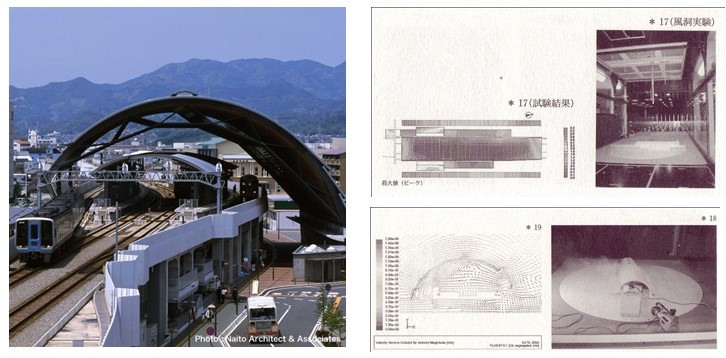
He also designed Kochi Station, completed in 2009. Designing the Kochi station, he also used wind tunnel test with Tokyo university bridge engineering department in two kinds; macro wind and micro wind in the same way as he did with the Makino museum. The only difference is he also did inner space excavation because diesel train (car) also runs this station.
Mogamigawa Park Center House
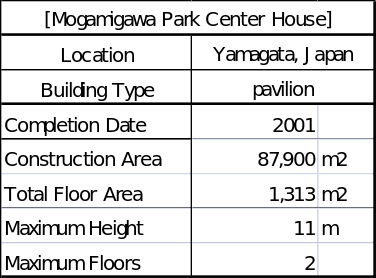
This project exemplifies Naito’s different approach to address the wind flow. This project is not based on the use CFD or wind tunnel test for designing but the architect viewed wind as major factor for design.

Mogamigawa Park Center House was constructed for “Green Fair 2002” Pavilion and since that time, the building has used for mutli-purposes. The site located in Yamagata prefecture northern part of Japan and near the Mogami river. Yamagata is known for having foehn phenomenon in June to August. Foehn Phenomenon (Foehn wind) is creates hot air blow along the bottom part of mountain. Sometimes this wind is known for causing the forest fire. Due to the Foehn Phenomenon, Yamagata records hottest temperature every summer.
Since the scenery of the site is so beautiful, Naito decided to design the center to give impression of transparency. He also insisted that its shape should correspond with the shape of river and topography. Naito also designed the pond front of the center. The pond’s water level increase during summer is instrumental for cooling down the temperature of building. Without water, the pond’s area turns into another passage way for people.
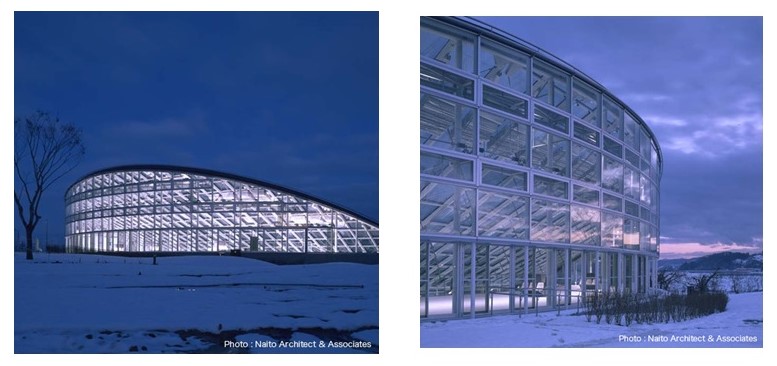
Naito was interested in pulling up air from natural convection by using the temperature differences among inner spaces. For this, he asked Panasonic Environmental Engineer to simulate the interior space to understand the temperature distribution and air current. According to the studies, placement of window openings were made and designed.